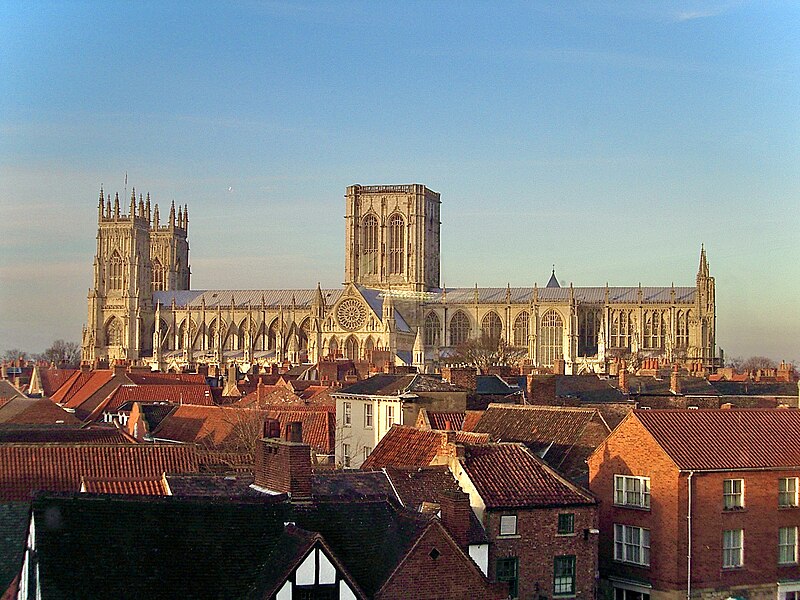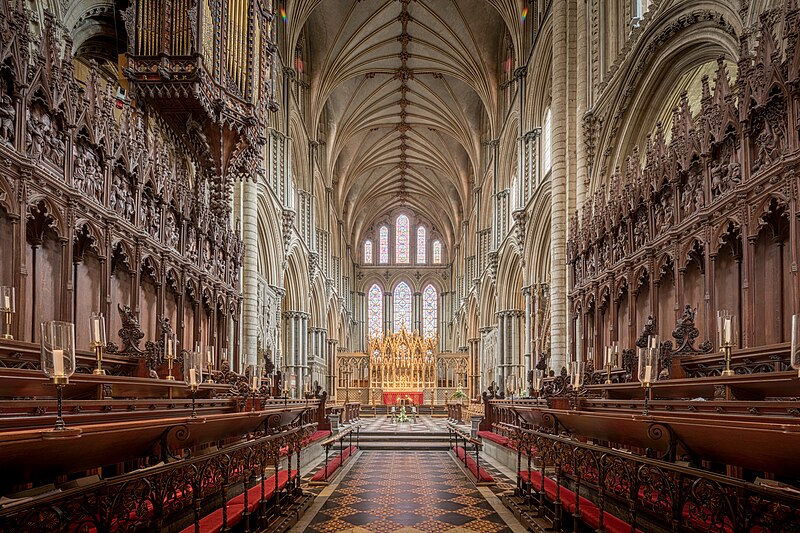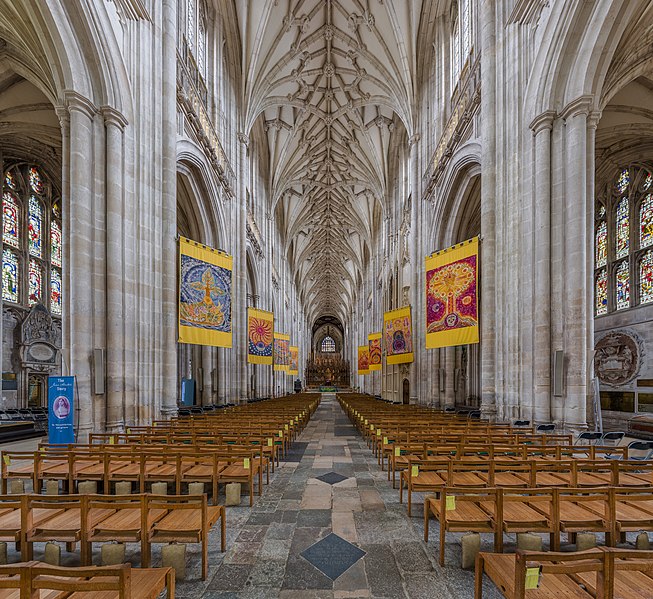Any film about events in English history will inevitably be
chock-full of some of the finest examples of English heritage. In the films Elizabeth (1998) and its sequel
Elizabeth: The Golden Age (2007), both starring Cate Blanchett as Queen
Elizabeth I, it is some of the country’s finest cathedrals that come to the
fore among the locations used.
In Elizabeth, the coronation scene was filmed at York Minster, which proved a splendid substitute for Westminster Abbey, where the
actual coronation took place on 15 January 1559. The Minster lies in the centre of this
historic city, and due to the flat terrain in the area surrounding it can be
seen from miles around. There has been a
place of worship at this spot since the 7th century, but it was not
until 732 that the first Archbishop of York was recognised by the Pope. The present building took a massive 250 years
to complete, starting in 1220 and ending in 1472. The Minster brought shocking images to our TV
screens in 1984 when a fire which started in the south transept raged out of
control, and firefighters were forced to deliberately collapse the roof to save
the rest of the building.
 |
| York Minster from M&S. Photo by Matze Trier, via Wikimedia Commons. |
The other cathedral which
makes an appearance in Elizabeth is Durham Cathedral. The cathedral plays the part of the royal
palace, and its distinctive pillars are seen in the scene where Elizabeth
searches for Lord Robert after receiving a message. Like York Minster, Durham Cathedral was
preceded by a humbler place of worship known as the Saxon ‘White Church’. The present-day building, which makes for a
picturesque sight overlooking the River Wear, was built between 1093 and 1133,
with further additions thereafter.
 |
| Durham Cathedral Nave. Photo by Michael D Beckwith, via Wikimedia Commons. |
In Elizabeth: The Golden Age we are taken further south,
with Ely Cathedral in Cambridgeshire playing an important role as the Palace of Whitehall, which in those
days was the main residence of the monarchs of the day. It is seen in a number of scenes, such as the
one where Elizabeth confronts the Spanish Ambassador, and when Sir Walter Raleigh
arrives bearing gifts from the New World.
Ely Cathedral is unusual in that, unlike most cathedral cities, Ely is
the size of a small town. In fact, the
cathedral came before the town, which grew up around it. There is a slate in the cathedral marking the
location of a former shrine to Ethelreda, daughter of the King of East Anglia,
who founded an abbey at the location of what is now the cathedral. The building dates from 1083, and was granted
cathedral status in 1109.
 |
| Ely Cathedral Choir East View. Photo by Michael D Beckwith, via Wikimedia Commons. |
The sequel covers the period leading up to, and including
the country’s spat with Spain, and Westminster Cathedral transports us over the
water to the court of King Philip II, as it was where the scenes were filmed
featuring the ranting king, plotting his invasion of England following the
execution of Mary, Queen of Scots. As a
Roman Catholic cathedral, Westminster Cathedral was a good choice. The cathedral is much younger than the others
used in the two films, with construction completed in 1903. Its main distinguishing feature is the
striped appearance of its exterior, fashioned from layers of brick and stone.
 |
| Westminster.cathedral.frontview.london.arp. Photo by Arpingstone, via Wikimedia Commons. |
One of the most dramatic scenes in the sequel is the attempt
on Queen Elizabeth’s life by Thomas Babington (Eddie Redmayne), an event which
is pure fiction, since in reality this particular individual did not get
anywhere near the Queen, although it is true that there was a plot to
assassinate her. The scene in question
was filmed in Winchester Cathedral.
Originally founded in 642 and known as Old Minster, the present-day
cathedral was started in 1079 at a site nearby, and the Old Minster was
demolished in 1093. The cathedral has
the distinction of being one of the largest in Europe, and includes many
notable features, such as the 17th century choir screen designed by
Inigo Jones.
 |
| Winchester Cathedral Nave 1, Hampshire, UK - Diliff. Photo by DAVID ILIFF, via Wikimedia Commons. |
Finally, for the main entrance to Whitehall Palace as seen
in the sequel, the producers made use of Wells Cathedral, specifically the
staircase linking the North Transept to Chapter House. Like Ely, Wells is another unusually small
cathedral city, nestling among the green fields of the Somerset
countryside. The cathedral was built to
replace an earlier church which had occupied the site since 705, and
construction spanned the period from 1176 to 1450. One of the cathedral’s best known features is
its astronomical clock dating from around 1325.
 |
| Wells cathedral chapter house brighter. Photo by Lamiai, via Wikimedia Commons. |
No comments:
Post a Comment